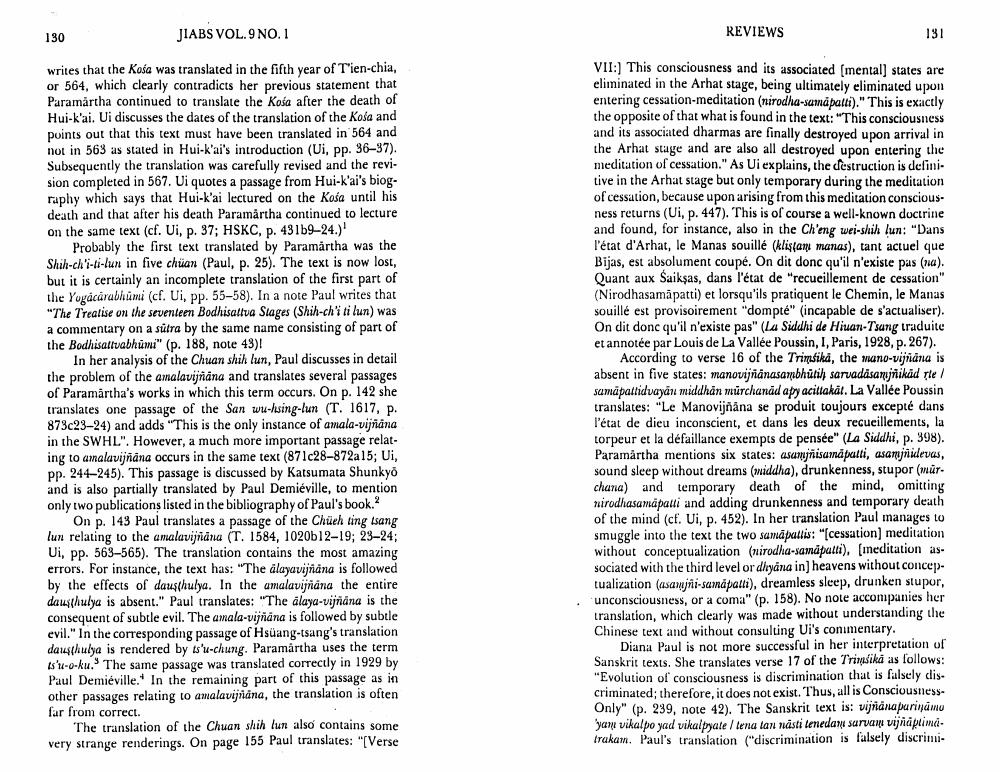________________
130
JIABS VOL. 9 NO.1
REVIEWS
131
writes that the Kosa was translated in the fifth year of Thien-chia, or 564, which clearly contradicts her previous statement that Paramartha continued to translate the Koša after the death of Hui-k'ai. Ui discusses the dates of the translation of the Koša and points out that this text must have been translated in 564 and not in 563 as stated in Hui-k'ai's introduction (Ui, pp. 36-37). Subsequently the translation was carefully revised and the revi. sion completed in 567. Ui quotes a passage from Hui-k'ai's biog raphy which says that Hui-k'ai lectured on the Koša until his death and that after his death Paramartha continued to lecture on the same text (cf. Ui, p. 37; HSKC, p. 431b9-24.)'
Probably the first text translated by Paramartha was the Shih-ch's-ti-lun in five chuan (Paul, p. 25). The text is now lost, but it is certainly an incomplete translation of the first part of the Yogácarabhumi (cf. Ui, pp. 55-58). In a note Paul writes that "The Treatise on the seventeen Bodhisattva Stages (Shih-chi di lun) was a commentary on a sutra by the same name consisting of part of the Bodhisattvabhūmi" (p. 188, note 43)!
In her analysis of the Chuan shih lun, Paul discusses in detail the problem of the amalavijñana and translates several passages of Paramartha's works in which this term occurs. On p. 142 she translates one passage of the San wu-hing-lun (T. 1617, p. 873c23-24) and adds "This is the only instance of amala-vijnana in the SWHL". However, a much more important passage relating to amalavijñāna occurs in the same text (871c28-872a15; Ui, pp. 244-245). This passage is discussed by Katsumata Shunkyo and is also partially translated by Paul Demiéville, to mention only two publications listed in the bibliography of Paul's book.?
On p. 143 Paul translates a passage of the Chüeh ting isang Lun relating to the amalavijñana (T. 1584, 1020b12-19; 23-24; Ui, pp. 563–565). The translation contains the most amazing errors. For instance, the text has: "The alayavijnana is followed by the effects of dausthulya. In the amalavijnana the entire dausthulya is absent." Paul translates: "The alaya-vijnana is the consequent of subtle evil. The amala-vijnana is followed by subtle evil." In the corresponding passage of Hsuang-tsang's translation dausthulya is rendered by ts'u-chung. Paramartha uses the term Isu-o-ku." The same passage was translated correctly in 1929 by Paul Demiéville. In the remaining part of this passage as in other passages relating to amalavijnana, the translation is often far from correct.
The translation of the Chuan shih lun also contains some very strange renderings. On page 155 Paul translates: "[Verse
VII:) This consciousness and its associated (mental) states are eliminated in the Arhat stage, being ultimately eliminated upon entering cessation-meditation (nirodha-samapatti)." This is exactly the opposite of that what is found in the text: "This consciousness and its associated dharmas are finally destroyed upon arrival in the Arhat stage and are also all destroyed upon entering the meditation of cessation." As Ui explains, the destruction is delini tive in the Arhat stage but only temporary during the meditation of cessation, because upon arising from this meditation consciousness returns (Ui, p. 447). This is of course a well-known doctrine and found, for instance, also in the Ch'eng wei-skih lun: "Dans l'état d'Arhat, le Manas souillé (klistan manas), tant actuel que Bijas, est absolument coupé. On dit donc qu'il n'existe pas (na). Quant aux Saiksas, dans l'état de "recueillement de cessation" (Nirodhasamāpatti) et lorsqu'ils pratiquent le Chemin, le Manas souillé est provisoirement "dompte" (incapable de s'actualiser). On dit donc qu'il n'existe pas" (La Siddhi de Hiuan-Tsang traduite et annotée par Louis de La Vallée Poussin, I, Paris, 1928, p. 267).
According to verse 16 of the Trimsika, the mano-vijnana is absent in five states: manovijnanasambhūtih sarvadásamujnikad nie / samāpattidvayan middhän mürchanad apy acittakat. La Vallée Poussin translates: "Le Manovijñana se produit toujours excepté dans l'état de dieu inconscient, et dans les deux recueillements, la torpeur et la défaillance exempts de pensée" (La Siddhi, p. 398). Paramartha mentions six states: asamjñisamapatti, asam jridevus, sound sleep without dreams (iddha), drunkenness, stupor (mūrchana) and temporary death of the mind, omitting nirodhasamapaiti and adding drunkenness and temporary death of the mind (cf. Ui, p. 452). In her translation Paul manages to smuggle into the text the two samapattis: "[cessation) meditation without conceptualization (nirodha-samapalti), (ineditation associated with the third level or dhyana in) heavens without concep
tualization (asami-samapatti), dreamless sleep, drunken stupor, "unconsciousness, or a coma" (p. 158). No note accompanies her translation, which clearly was made without understanding the Chinese text and without consulting Ui's conimentary.
Diana Paul is not more successful in her interpretation of Sanskrit texts. She translates verse 17 of the Trimsika as follows: "Evolution of consciousness is discrimination that is falsely discriminated; therefore, it does not exist. Thus, all is Consciousness Only" (p. 239, note 42). The Sanskrit text is: vijnanapurināmu yaw vikalpo yad vikalpate / tena tan násti tenedaw survan vijfdprima. trakam. Paul's translation ("discrimination is falsely discrimi




